Coming up with the perfect name for a character can feel like naming an unborn child—or naming a pet before you meet it. Sometimes, a name pops into your head and just works. Other times, you might go through list after list, changing it again and again until something finally clicks.
Whether you’re a planner or a go-with-the-flow type of writer, naming characters can be one of the trickiest parts of the writing process. That’s why we’ve put together a set of tips that show you how to come up with character names. By the end of this article, you’ll be ready to tackle this time-consuming yet exciting task with a more confident mindset.
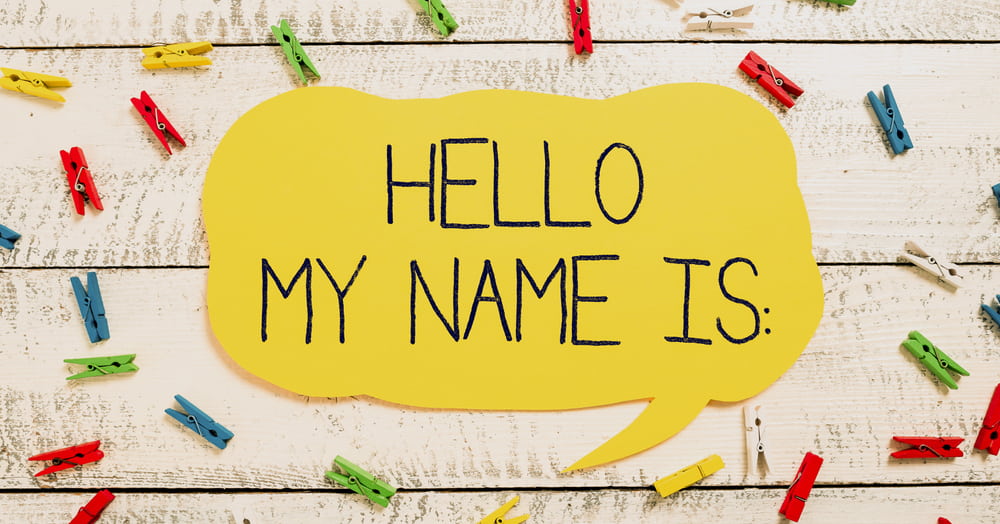
Photo from Depositphotos
What Makes a Good Character Name?
Knowing the characteristics of a good name the characteristics of a good name can help you pick out iconic ones for the cast of your story. You’ll also be able to choose names that match the setting and themes of your story, making it easier for readers to stay engaged and immersed. So, let’s cover the general recommendations for choosing character names:
1. They Are Easy to Read and Pronounce
Make sure the syllables in the name you choose are clear enough and easy to read. For instance, consider these two names: “Kate” and “Cayhte.” While both names have similar pronunciations, the former is easier to read than the latter.
That’s not to say that you shouldn’t use unique or even foreign names, but try to simplify the spelling wherever you can. Moreover, keep in mind that a memorable character is defined by their actions, not by a complicated name.
2. They Make Sense Within the Context of the Story
Parents usually name their children at birth. So, make sure that the name you choose for your character makes sense as a baby name in the world of your story. In other words, don’t give your character an obscure fantasy name like “Filvendor” if they live in a modern world similar to ours. Similarly, modern names like “James” and “Micah” might not work well in a world inhabited by dwarves or elves.
3. They Reflect the Character’s Personality or Their Role in the Story
Oftentimes, many characters have names that explain some part of their personality or their role in the story. For example, a villain might have a name that feels unsettling or sinister, such as “Victor Graves.” Alternatively, a self-sacrificing character might have a name like “Irene,” which is derived from an Ancient Greek word meaning “peace.” This point is a good one to keep in mind for central characters as well as secondary ones.
Not sure you understand your character well enough to choose a fitting name? Then learn all about the different types of characters first!
How to Find Good Names for Your Characters
So, how exactly do you go about naming characters? To start, you might need to do some research first, depending on the genre of your work and the background of your character. Then comes the fun part: choosing a fitting name! So, without further ado, let’s check out a few tips and tricks that can help us with the naming process.
1. Look Up Common Names from the Time Period You’re Writing About
Even in individual countries, naming trends change every few years. That’s why researching common names from the relevant time period can help keep your story grounded in its setting. So, don’t be tempted to add a “Jessica” to a story set in the Middle Ages, centuries before the name was invented by Shakespeare!
💡Pro Tip: Even if your story is set in the future, naming trends can still offer some inspiration. Start by studying how names have evolved over the years. From there, you can get creative and predict future ones yourself, or you can even invent your own.

2. Understand the Naming Conventions of the Community Your Character Belongs To
Most, if not all, cultures have their own rules and conventions when it comes to names. Some use religious or spiritual symbolism, while others draw from the geography of their land. Many people also name their children after positive virtues or traits.
So if your character belongs to or identifies as part of a certain culture, make sure to research it well. By doing so, you’ll enrich your story whilst also respecting the original culture as well as the readers of your story. For example, T’Challa (from Black Panther), without the apostrophe, is a common name in Togo and Nigeria that was once associated with brave warriors in the 15th century.

3. Identify the Role of the Character in the Story
Each character in a story has a purpose, even if it’s just to push the plot forward. So, clearly identifying your character’s role in the story can help you find a name that fits them perfectly.
To start, think about the character’s beliefs and values. What events shaped their beliefs and behavior? How do they influence the plot and affect other characters? By answering these questions, you’ll get a clearer sense of who they are, and what kind of name would suit them. For example, you might name your character after their main flaw, like Scrooge from A Christmas Carol.
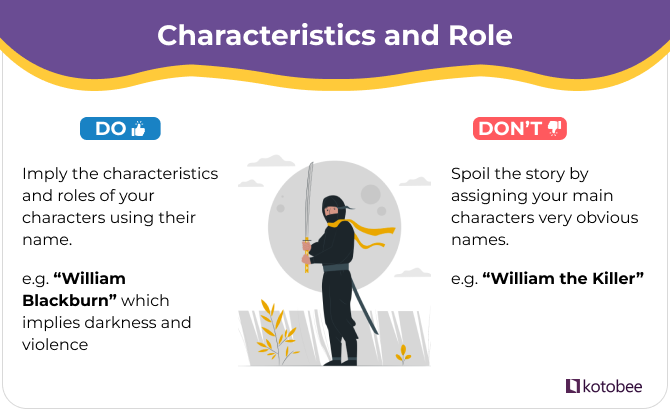
💡 Pro Tip: Note that a character’s name can also be ironic. This means that their name can make readers expect them to act in a way that contrasts with their true selves. This use of irony can have different objectives, such as amusing readers or as commentary on the story’s themes. For example, a vile, psychopathic villain might have a name like Catherine, which means pure.
4. Research Ancient Languages and the Linguistic Origins of Certain Names
Within the confines of the English language alone, you’ll find word roots that come from a variety of older languages, such as Latin. Additionally, many common names in a particular language tend to have older linguistic origins as well. All of this means that you can research the history of a particular language and end up with many potential names for your character!
Here are a couple of characters whose names were derived from ancient languages: Luna Lovegood from Harry Potter, whose first name means “moon” in Latin, and Apollo Creed from Rocky, whose first name means “destroyer” in Ancient Greek.

5. Gather Ideas from Other Works in the Genre
Each genre tends to have its own naming conventions. For example, sci-fi and fantasy stories tend to have characters with distinctive or unusual names, like Spock from Star Trek. In contrast, historical fiction usually reflects the naming trends of the era in which the story is set, just like Liesel Meminger from The Book Thief.
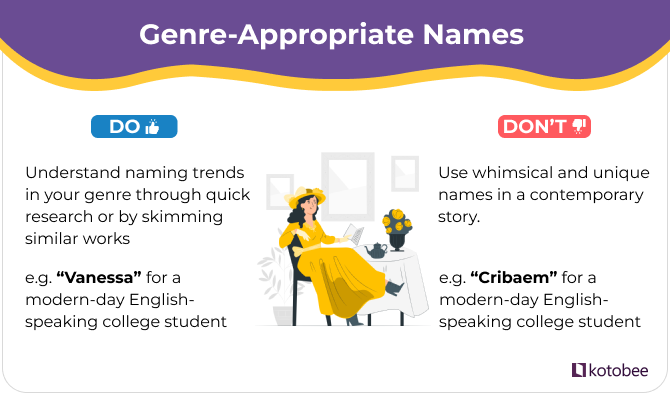
6. Take Inspiration from Your Own Name or Those You Know in Real Life
There is an infamous saying that authors tend to name mean characters after their bullies or exes. Don’t worry, this pattern can be taken in a positive direction, too! For instance, you can name a lovable protagonist after your childhood best friend. Or, you can take parts of your own name and use those for a character you share many traits with.
In A Nightmare on Elm Street, for example, Freddy Krueger was named after the director’s childhood bully. On the other hand, Cosmo Kramer (from Seinfeld) was inspired by the bold neighbor of the show’s co-creator.
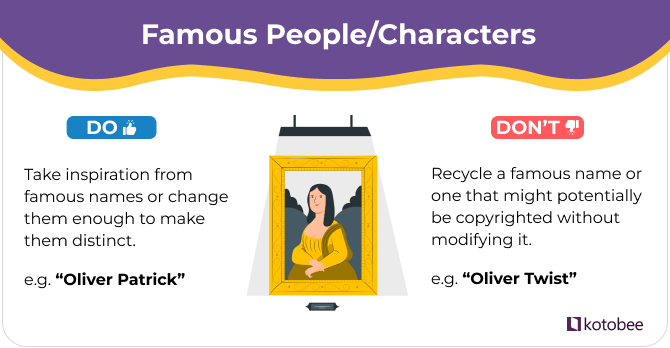
7. Use an Online Name Generator or Baby Name Lists
Sometimes, you need an extra helping hand to assist you in finding the right character names. That’s where baby name lists and online name generators can come in! Online lists can come in handy for realistic names, while generators can be useful for coming up with unique ones.
Here are a few useful tools: Behind the Name, Fantasy Name Generators, and Reedsy’s Character Name Generator.

8. Try Using Nicknames or Titles in Place of a Full Name
Some fictional characters might end up with long names that are difficult to remember. In such cases, referring to them by a nickname or a title can make it easier for readers to remember them, as is the case with Lady Catherine (Lady Catherine de Bourgh) from Pride and Prejudice. This trick isn’t only for long names; even shorter names can be replaced with something more distinctive. Examples include Marty McFly (Martin Seamus, Back to the Future) and Professor Moriarty (James Moriarty, Sherlock Holmes).
You can also add prefixes, such as Dr. or Miss, or suffixes, such as Ph.D. or Jr., to make characters stand out or convey authority. Think, for example, of characters like Dr. Crane (Dr. Jonathan Crane, Batman Begins) and King Aerys II (King Aerys II Targaryen the Mad King, Game of Thrones).

9. Use Alliteration for Your Character’s Full Name
Alliteration—the repetition of a sound at the beginning of two or more neighboring words—adds a poetic element to any text, and character names are no different. By using the same letter for a character’s first and last names, you can make even the most common names memorable and iconic. Think of Severus Snape (from Harry Potter) and Peter Parker (from Spider-Man).
Just use this tactic wisely! After all, alliterative names are more common in superhero stories and books for younger readers, meaning they might not always fit in a story for mature audiences.
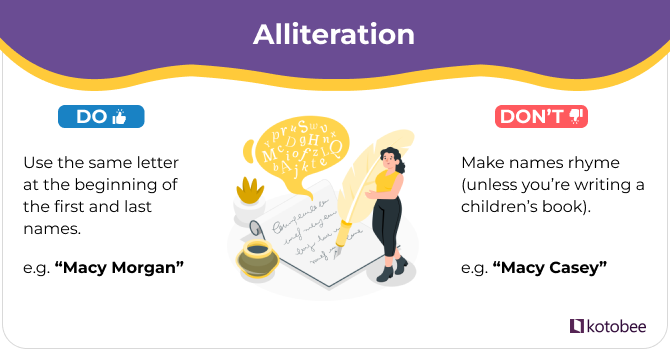
10. Reverse the First and Last Names of the Character
Usually, first names tend to be simpler or shorter than last names, as is the case with names like “Matt Thunderbird.” But what if you reversed them? You might turn a regular, unassuming name into a memorable and iconic one.
For instance, you can name a character “Henderson Joey” instead of “Joey Henderson,” or “Maximilian Levi” instead of “Levi Maximilian.”
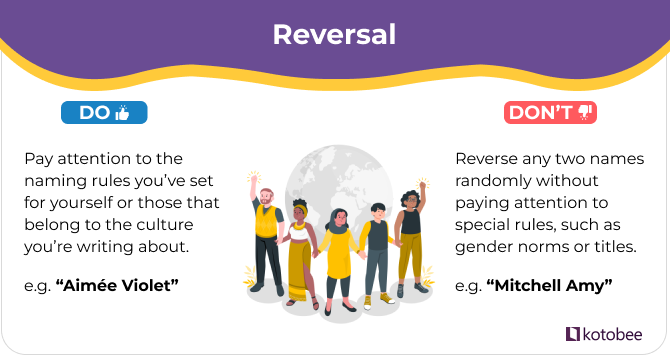
11. Use a Hyphenated Name
In real life, people might have hyphenated first or last names. First names can take hyphens if, for example, they’re composed of two names in one, such as “Mary-Jane” from Spider-Man. On the other hand, hyphenated last names usually arise from marriage or having mixed heritage, such as “Bernard-Cheng.”
In fiction, hyphenated names are more flexible, especially in superhero media. These names usually take hyphens to make them more readable or to set them apart from other characters. A famous character with such a name is Obi-Wan Kenobi (Star Wars).

12. Refer to Certain Characters Using Titles or Descriptions
Some characters in fiction might not have proper names and are instead referred to by titles or descriptions. A few examples of such characters include The Doctor (Doctor Who), The Child (The Mandalorian), and Cigarette Smoking Man (The X-Files). This naming route can add more mystery to the character or help you introduce side characters with smaller impacts on the plot.

13. Invent an Original Name
In heavy-worldbuilding genres like fantasy or sci-fi, original names can help make your world feel truly unique. You can come up with a completely new word or use existing nouns to create a unique name. Two characters you might know with invented names are Katniss (from The Hunger Games) which was inspired by a real plant and Wendy (from Peter Pan), which didn’t exist before the story!

14. Pronounce the Name Out Loud to Check Its Readability
Once you’ve chosen a name, try reading it out loud in a couple of sentences. This can help you get a feel for how well it flows with the rest of the text and whether it’s easy enough to read. If the name feels awkward or disrupts the rhythm, it might need tweaking. This rule also applies to foreign names, though it’s more relaxed in this case.
Let’s take a look at a couple of examples so we can truly see the impact of readability on character names. Starting with simple ones, “Christoff” is easier to read than “Krzysztof.” On another note, names like Numuhukumakiaki’aialunamor (The Stormlight Archives) are quite difficult to read in context, even if you have no trouble pronouncing them!
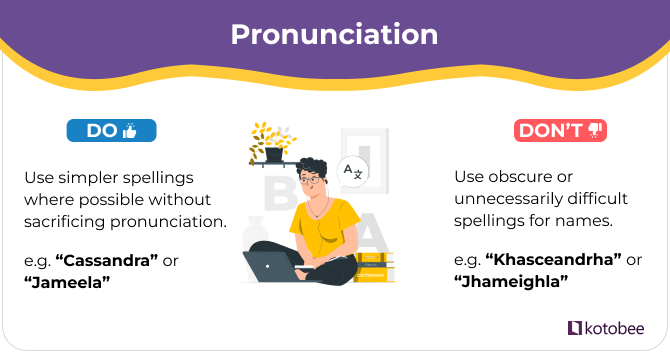
Final Thoughts
Before you get creative with any art form, it helps to understand its basics first, and naming characters is no different. Once you understand the fundamentals, you can start bending or even breaking some rules to fit your story. As long as the names you pick aren’t offensive or difficult to read repetitively, you’re good to go.
Do you know any more tips for naming characters that we haven’t mentioned in the article? Feel free to mention them in the comments.
.
Read More
How to Plot a Novel: An Author’s Guide (with Tips and Tricks)
How to Write a Compelling Story Outline: A Step-by-Step Guide

